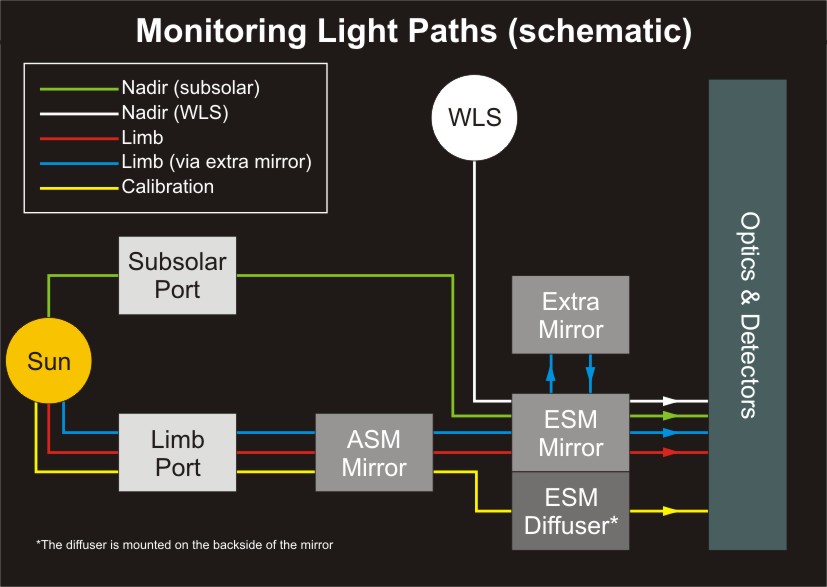
Degradation
correction V10
M-Factors
(V6.x/7.x)
Main Page
Plots:
Full
4 weeks
Medians
4 weeks
Downloads
Release
Notes
News
M-Factors at
IUP Bremen
SCIAMACHY
SCIAMACHY
M-factors
Introduction
Short-Term Concept
Long-Term Concept
Data
References
Contact
This is the SCIAMACHY m-factors main page. This pages refers to the SCIAMACHY Level 0-1b processor versions 6.xx and 7.xx.
The most recent processor version is 10.0!
M–factors are used in the 0-1b processor to compensate for
the radiometric degradation of SCIAMACHY.
In general, an m-factor is defined as the ratio between a
measured spectrum of a constant light source (typically
the sun) at a certain time to a spectrum obtained for the
same optical path at a reference time. M-factors therefore
provide an end-to-end degradation correction for each
individual light path.
M–factors have an impact on the polarization correction and on the absolute radiometric calibration.
The m–factors for the science detectors are multiplicative factors to the absolute radiometric calibration of SCIAMACHY.
The m–factors for the PMDs influence in a non-linear way the polarization correction of SCIAMACHY.
Regarding the m–factors for the polarization requires re-processing of the full mission, as the calculation of the polarization correction has to be done by the Level 0-1b processor.
The concept for calculation and provision of m-factors foresees two steps:
SCIAMACHY long-term monitoring results based on partly calibrated Level 0 data are also available.
The m-factor impact on polarization correction is
neglected within the short–term solution.
The m–factors are provided by an external database, which than can be applied by a modified Level 1b-1c applicator.
Advantages of this approach are:
On long-term, a full set of m-factors including PMDs can
be set up. For this concept, changes of the Level 0-1b
processor are necessary.
The m-factors are included in the Level 1 product and cannot be switched off, if polarization correction or absolute radiometric calibration is needed.
Advantage of this approach is full consistency for reprocessed products.
Currently only
m-factors for the short-term solution are available. Click
here to download the data
base.
If you are interested in more information on SCIAMACHY
m-factors contact Stefan
Noël or Klaus
Bramstedt.
Author of this page: Stefan Noël


©2008
This is the SCIAMACHY m-factors main page. This pages refers to the SCIAMACHY Level 0-1b processor versions 6.xx and 7.xx.
The most recent processor version is 10.0!
 Introduction
Introduction
M–factors are used in the 0-1b processor to compensate for
the radiometric degradation of SCIAMACHY.
In general, an m-factor is defined as the ratio between a
measured spectrum of a constant light source (typically
the sun) at a certain time to a spectrum obtained for the
same optical path at a reference time. M-factors therefore
provide an end-to-end degradation correction for each
individual light path.M–factors have an impact on the polarization correction and on the absolute radiometric calibration.
The m–factors for the science detectors are multiplicative factors to the absolute radiometric calibration of SCIAMACHY.
The m–factors for the PMDs influence in a non-linear way the polarization correction of SCIAMACHY.
Regarding the m–factors for the polarization requires re-processing of the full mission, as the calculation of the polarization correction has to be done by the Level 0-1b processor.
The concept for calculation and provision of m-factors foresees two steps:
- A short-term solution where only science detector readouts are corrected.
- A long-term solution where all light paths are corrected.
SCIAMACHY long-term monitoring results based on partly calibrated Level 0 data are also available.
 Short-Term Concept
Short-Term Concept
The m-factor impact on polarization correction is
neglected within the short–term solution. The m–factors are provided by an external database, which than can be applied by a modified Level 1b-1c applicator.
Advantages of this approach are:
- The application of m-factors can be switched on and off by the Level 1 data users.
- M-factors are decoupled from the operational 0-1b processing, therefore a fast implementation is possible.
- Updates of the m-factor data base are possible
independent from a Level 1 re-processing.
 Long-Term Concept
Long-Term Concept
On long-term, a full set of m-factors including PMDs can
be set up. For this concept, changes of the Level 0-1b
processor are necessary. The m-factors are included in the Level 1 product and cannot be switched off, if polarization correction or absolute radiometric calibration is needed.
Advantage of this approach is full consistency for reprocessed products.
 Data
Data
Currently only
m-factors for the short-term solution are available. Click
here to download the data
base. References
References
- K. Bramstedt, Calculation of SCIAMACHY M-Factors, Technical Note, IFE-SCIA-TN-2007-01-CalcMFactor, Issue: 1, 2008. (PDF file, ca. 1.3 MB)
 Contact
Contact
If you are interested in more information on SCIAMACHY
m-factors contact Stefan
Noël or Klaus
Bramstedt. Author of this page: Stefan Noël


©2008
